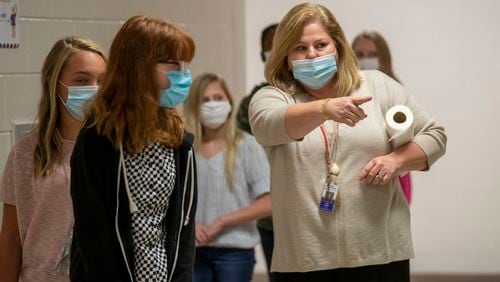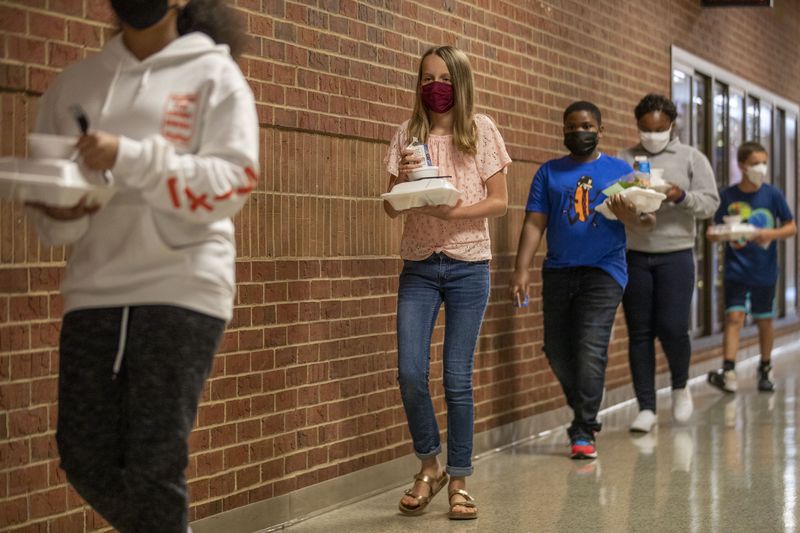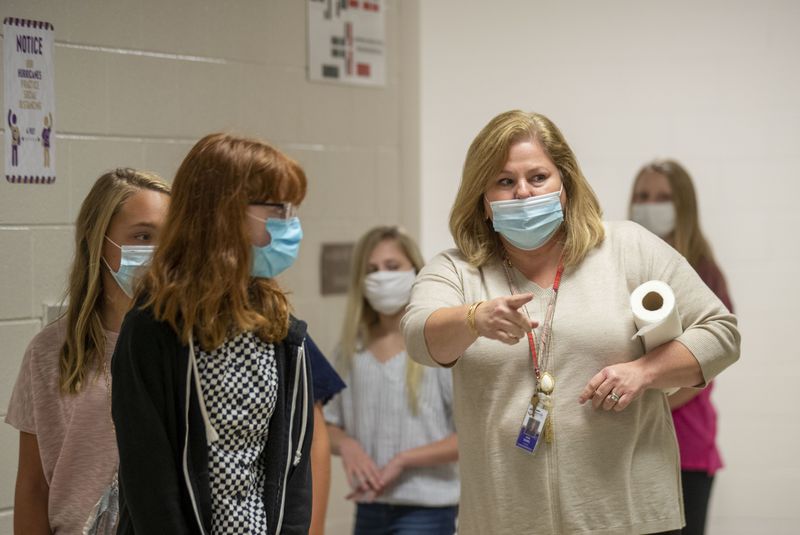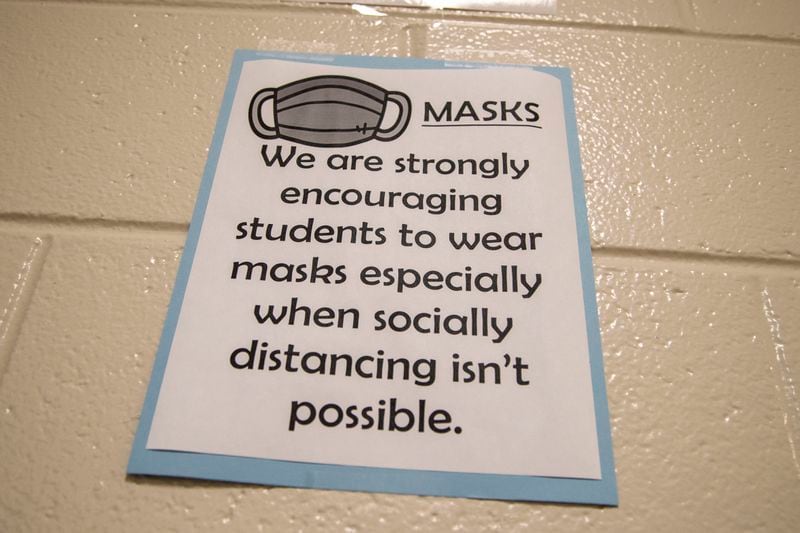DeKalb County School District Superintendent Cheryl Watson-Harris’ announcement on Aug. 10 that 80 district employees and students tested positive for COVID-19 since July 1 was an admission many metro Atlanta school systems have been reluctant to make.
Before that, the state’s third-largest school district had announced publicly just one instance where an employee had tested positive for the virus. This was despite statements declaring all confirmed coronavirus exposures and related school site closures would be reported to the public.
“We feel confident in our decision to begin school Aug. 17 in a virtual space,” Watson-Harris said during her school board’s Aug. 10 meeting, citing the increase in positive coronavirus cases.
Before August, fewer than a dozen infections had been reported by metro Atlanta school districts where teachers and administrators had gathered to prepare for the big restart. Since then, case counts have skyrocketed, with more than 1,000 positive cases acknowledged — and thousands more exposed — since May, in records received by The Atlanta Journal-Constitution.
The recent numbers include both positive cases reported as in-person instruction resumed, as well as reports previously withheld. Some districts still have not publicly shared the full scope of the pandemic in their schools as parents decide whether it is safe to send their children back into them.
The disparity in reporting — as well as from where the data will come — may better explain why much of the region has started or will start the school year online. School superintendents even admit struggling with the weight of the decision they’re tasked with making, with agencies such as the state’s departments of education and health adamant any coronavirus guidelines they release are just that.
“They literally have dropped a life-and-death decision on a superintendent’s desk,” Grant Rivera, superintendent of Marietta City Schools, said last month after announcing his district would start the year online. “It gets pushed out to us and we’re supposed to do something about it. Everybody gets to dodge this except for the superintendents.
Credit: ALYSSA.POINTER@AJC.COM
Credit: ALYSSA.POINTER@AJC.COM
Some of the early-opening school districts have designed COVID-19 reporting systems on the fly, amending the way they divulge their case counts as the numbers exploded and forced some schools to close, including half the high schools in Cherokee County after more than 1,000 students and teachers were quarantined.
Absent a state-coordinated reporting system, each of Georgia’s 180 school districts will have to confront the same problem and devise its own solution, likely leading to inconsistent or haphazard methods of reporting. That will make comparisons between schools and school districts difficult or impossible for parents and others trying to assess the risk at each location.
Epidemiologist Shanta Dube said that with so many schools opening, Georgia -- and the nation for that matter -- should have planned to collect and report uniform data about the number of students infected and quarantined at each school.
“There has got to be some kind of standard in place both for the researchers and the parents — just so we can understand what’s happening … what’s working and what’s not,” she said.
If each of Georgia’s 180 school districts establishes its own collection and reporting protocol, Dube said, “that is a public health nightmare.”
Credit: ALYSSA.POINTER@AJC.COM
Credit: ALYSSA.POINTER@AJC.COM
The AJC requested documents more than two weeks ago from metro Atlanta’s largest school districts laying out the number of positive coronavirus cases directly impacting schools since May 1. Many responded within days with copies of emails sent to their local health departments after an employee or student tested positive, and spreadsheets showing details of a positive case related to the district.
Fulton County Schools said it would take three weeks to compile the information. The DeKalb County School District responded Aug. 10 with a note that it would take “at least ten business days” to compile requested documents. Both districts sent the newspaper a bill for the public records.
“This seems an especially important time for [school districts] to be transparent, given decisions they’re making around public health,” said University of Georgia media law professor Jonathan Peters, adding that the Georgia Open Records Act tasks governmental agencies with “a special burden to be as transparent as possible, not to run the other way.”
The two state agencies most likely to coordinate such reporting have told The AJC they have no plans to. A spokeswoman for the Georgia Department of Education deferred the question to the Georgia Department of Public Health, saying any state-level reporting would come from there.
When the AJC asked a spokeswoman at the state public health agency about that, she responded in an email: “No – have you checked with Ga DOE?”
State School Superintendent Richard Woods had agreed to an interview about the issues surrounding school re-opening, but on Tuesday backed out with no explanation other than an apologetic email from his spokeswoman saying simply that he was “no longer available.”
Responding to a question posed to Gov. Brian Kemp on whether the state would assume responsibility for a statewide count of COVID-19 cases in schools, Kemp spokeswoman Candice Broce said: “District health directors work in tandem with the Department of Public Health’s leadership team to evaluate options, provide guidance, and ensure the health and safety of Georgians across our state.”
Credit: ALYSSA.POINTER@AJC.COM
Credit: ALYSSA.POINTER@AJC.COM
The stakes are high for school districts, among the largest employers that also provide mental and physical health for students, as well as a source for nutrition for many, especially those from low socioeconomic backgrounds. Many see schools reopening as a sign that life can start returning to normal.
“We understand that children are resilient,” Sandra Ford, director of the DeKalb County Board of Health, said during a recent DeKalb County School District town hall on athletics in the age of the coronavirus. “The concern (is) the other folks around them. Faculty, bus drivers, cafeteria and custodial staff.”
Some school district leaders, after deciding late last month to start the new year online, said they were forced to acknowledge tracing a positive coronavirus case’s path was much too daunting while dealing with thousands of potentially asymptomatic students and older teachers, some of whom have pre-existing conditions.
”What I learned this past week is … our local public health officials said it could take someone eight to 10 days to schedule a test, five days to get results, one to three more days to contact trace,” Rivera, the Marietta City Schools superintendent, said in July after deciding his district would start the new year virtually. “You’re anywhere from 15-23 days after someone says they’re going to get a test. If I ask you who you were next to for 15 minutes some 23 days ago, you’re not going to have a clue.”
School started Tuesday in Cartersville, a tiny school district northwest of Atlanta with about 5,000 students, which could fill two Gwinnett County high schools. What works for Gwinnett would not necessarily work for Cartersville, which is why Superintendent Marc Feuerbach said he is fine without state coordination of the reporting.
Feuerbach said he developed his own case reporting plan by looking to other school districts. He would rather get ideas from his peers across the state.
“That’s what we do right now,” he said. “We’re communicating with other superintendents saying, ‘what are you doing?‘”
Steve Smith, superintendent of schools in Bleckley County, said he would like to see more robust data about the spread of the virus in his community, such as infection and hospitalization numbers segregated by age, since he suspects older people rather than students are behind the local increases. As of Wednesday, Bleckley had more than 1,000 confirmed cases per 100,000 over the prior two weeks, roughly five times the state average.
He said his district plans to publicize updates on school-related infections and quarantines each Monday, but the numbers will be for the whole district rather than for each school.
In a small town, he said, it would be too easy for people to identify who was affected, violating federal student and medical privacy rules.
”We’re constantly balancing trying to keep the public informed but also maintain confidentiality with this private information,” Smith said.
Many school districts may soon follow the reporting trail blazed by Cherokee County. The school system north of Atlanta was among the first to open in the state — and to face calls for public reporting of coronavirus information.
As of Wednesday afternoon, a district webpage originally intended as an archive contained the reports for only that day and the prior two. The reports are cumulative and cases are added without dates, so parents have been taking daily screenshots to preserve the record, said Jamie Chambers, a father there who has established a network of school watchers on Facebook.
”They can say they’re reporting what’s going on but it genuinely seems like they’re intentionally making it confusing,” he said.
He would like the state to establish a uniform reporting process so parents have enough information to judge if their school is becoming dangerous.
Said Chambers: ”They may rethink having their kid in there if things are changing that rapidly.”
The Cherokee schools said the contact tracing work that their staff is doing is “very labor intensive” and they have to take time away from it to help with the disclosure reports. Spokesperson Barbara Jacoby described a system being designed and amended in real-time, as the rising case counts rendered initial reporting methods “ineffective.”
“It’s worth noting that our level of public reporting is not required in any way, but is keeping with our longstanding commitment to transparency,” Jacoby wrote in an email, adding that the district had received no complaints about the reporting — “only gratitude that we are providing it and doing so daily.”











